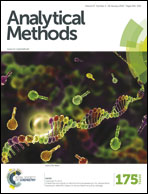Real-time monitoring AP site incision caused by APE1 using a modified hybridization probe
Abstract
The human AP-endonuclease (APE1), an essential multifunctional protein, plays a central role in the repair of oxidative base damage via the DNA base excision repair pathway. APE1 overexpression is often observed in tumor cells, and confers resistance to various anticancer drugs; its downregulation sensitizes tumor cells to those agents via induction of apoptosis. Thus, the assay of APE1 activity is necessary for tumor diagnosis, therapy and target drug development. Here, we introduced a simple and real time fluorescence method based on a double-stranded fluorescent probe for APE1 assay that is suitable for automation and clinical use. Results demonstrated that the detection limit of this method was 0.024 U mL−1, and the Km and kcat values are 15 nM and 15 s−1, respectively. Moreover, the method was used to screen inhibitors of APE1 and the results showed that cephalosporins can strongly inhibit APE1 activity with an IC50 value of 0.02 μM. Finally, the method was used to detect the change of APE1 activity in tumor cell samples with different treatments and preeminent fluorescence signals were obtained. In summary, our results indicate that the simple, rapid and sensitive method is hopeful for high-throughput diagnosis of complicated biosamples and drug screening in vitro.


 Please wait while we load your content...
Please wait while we load your content...